- Joined
- Feb 2, 2011
- Messages
- 2,093
NEW RELEASES FOR MAY 2023
THE TROJAN WAR
THE GREEKS
Traditionally, the Trojan War arose from a sequence of events beginning with a quarrel between the goddesses Hera, Athena and Aphrodite. Eris the goddess of discord, was not invited to the wedding of Peleus and Thetis, and so arrived bearing a gift. A golden apple, inscribed “for the fairest”.
Each of the goddesses claimed to be the “fairest”, and the rightful owner of the apple. They submitted the judgement to a shepherd they encountered tending his flock. Each of the goddesses promised the young man a boon in return for his favour. Power, wisdom, or love. The youth, in fact Paris, a Trojan prince who had been raised in the countryside, chose love, and awarded the apple to Aphrodite.
As his reward, Aphrodite caused Helen, the Queen of Sparta, and the most beautiful of all women, to fall in love with Paris.
The judgement of Paris earned him the ire of both Hera and Athena, and when Helen left her husband, Menelaus, the Spartan king, for Paris of Troy, Menelaus called upon all the kings and princes of Greece to wage war upon Troy.
Menelaus’ brother Agamemnon King of Mycenae, led an expedition of Achaean troops to Troy and besieged the city for ten years because of Paris’ insult. After the death of many heroes, including the Achaeans, Achilles, Ajax and the Trojans Hector and Paris, the city fell to the ruse of the Trojan Horse.
The Achaeans slaughtered the Trojans, except for some of the women and children whom they kept or sold as slaves. They desecrated the temples, thus earning the wrath of the gods.
Few of the Achaeans returned safely to their homes, and many founded colonies in distant shores.
The Romans later traced their origin to Aeneas, Aphrodite’s son and one of the Trojans, who was said to have led the surviving Trojans to modern day Italy.
GREEK INFANTRY
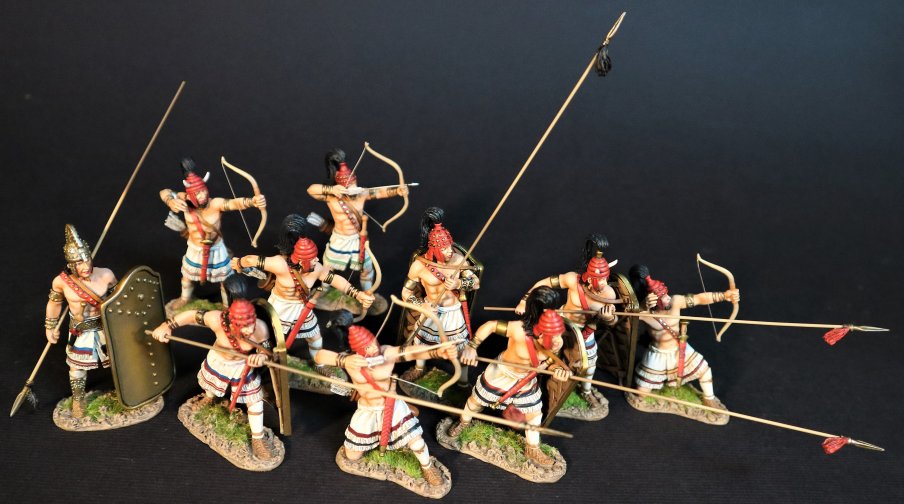
The Achean Greece, or Mycenean civilization was a major Bronze age power alongside Egypt, Assyria, Phoenicia and the Hittites. The rise of this militaristic society, and the development of Greek armour and weapons would eventually grant the Greeks immortality through the literary preservation of their great conflict of the Trojan War.
Normally swords are viewed as ubiquitous military armaments, but were not initially common during the early Bronze Age. Large scale close quarter conflict rarely occurred, and ritualized duels involving armoured warriors may have formed the main part of dispute resolution.
Swords used large amounts of valuable bronze and were also useless for hunting due to a lack of reach. The introduction of the sword as an object designed specifically for use against other humans marks the growth of conflict as a part of society.
Spears are perhaps the most common weapon type in human history and have been used in hunting since the palaeolithic era. Boars were hunted for their tusks, used in helmets, and lions were hunted as a noble pursuit and to teach agility and discipline.
The famous “Lion Hunt Dagger” from a grave in Mycenae depicts such an event. In hunting these dangerous animals, the spear was invaluable due to its flexibility and long reach. In Bronze Age warfare the spear was important, as it used much less bronze than large bladed weapons such as swords and double edged axes.
This meant lower class citizens could be armed with a spear, which meant it was easier to equip large bodies of men in times of war.
Longer spears would be wielded two handed and used in a thrusting motion (visible in frescoes from Pylos). The longer reach would have been invaluable if fighting against, or from the Bronze Age war chariots.
Shorter spears were used one handed with a shield and could also be thrown, not dissimular to the later Classical Greek phalanx.
The bow as a hunting weapon was well established, and arrows were effective in piercing bronze armour.
As illustrated on the “Lion Hunt Dagger” and other frescoes, it seems common for archers to be combined with tower shield spearmen as a strong defensive unit, especially to withstand early chariot warfare.
In such massed formations, the 12ft long spear would be far from impractible, and would have been a perfect weapon for levelling against an opposing line of infantry, or for defence against chariots.
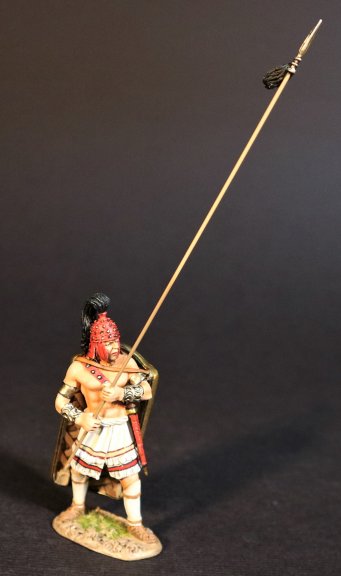
TWG-26
THE TROJAN WAR,
THE GREEKS
GREEK SPEARMAN.
(1 pc)
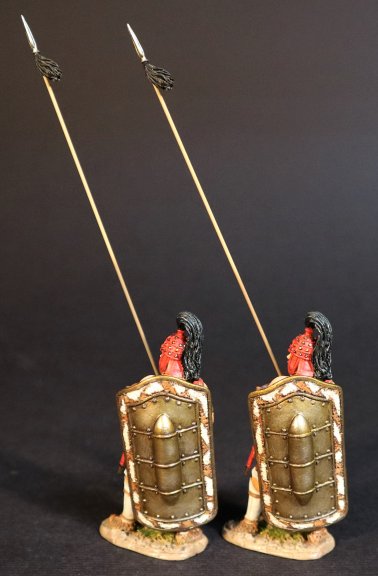
TWG-26N
THE TROJAN WAR,
THE GREEKS
GREEK SPEARMEN.
(2 pcs)
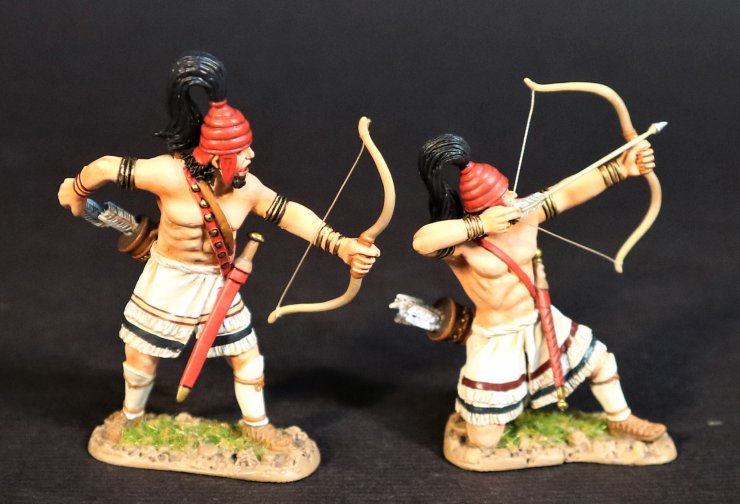
TWG-38
THE TROJAN WAR,
THE GREEKS
GREEK ARCHERS.
(2 pcs)
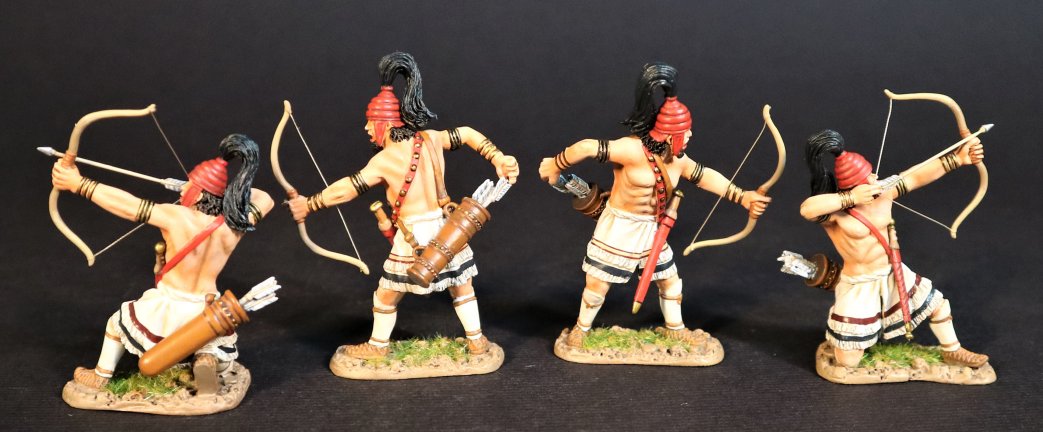
TWG-38N
THE TROJAN WAR,
THE GREEKS
GREEK ARCHERS.
(4 pcs)
**PLEASE CONTACT YOUR LOCAL DEALER FOR FURTHER INFORMATION**
THE TROJAN WAR
THE GREEKS
Traditionally, the Trojan War arose from a sequence of events beginning with a quarrel between the goddesses Hera, Athena and Aphrodite. Eris the goddess of discord, was not invited to the wedding of Peleus and Thetis, and so arrived bearing a gift. A golden apple, inscribed “for the fairest”.
Each of the goddesses claimed to be the “fairest”, and the rightful owner of the apple. They submitted the judgement to a shepherd they encountered tending his flock. Each of the goddesses promised the young man a boon in return for his favour. Power, wisdom, or love. The youth, in fact Paris, a Trojan prince who had been raised in the countryside, chose love, and awarded the apple to Aphrodite.
As his reward, Aphrodite caused Helen, the Queen of Sparta, and the most beautiful of all women, to fall in love with Paris.
The judgement of Paris earned him the ire of both Hera and Athena, and when Helen left her husband, Menelaus, the Spartan king, for Paris of Troy, Menelaus called upon all the kings and princes of Greece to wage war upon Troy.
Menelaus’ brother Agamemnon King of Mycenae, led an expedition of Achaean troops to Troy and besieged the city for ten years because of Paris’ insult. After the death of many heroes, including the Achaeans, Achilles, Ajax and the Trojans Hector and Paris, the city fell to the ruse of the Trojan Horse.
The Achaeans slaughtered the Trojans, except for some of the women and children whom they kept or sold as slaves. They desecrated the temples, thus earning the wrath of the gods.
Few of the Achaeans returned safely to their homes, and many founded colonies in distant shores.
The Romans later traced their origin to Aeneas, Aphrodite’s son and one of the Trojans, who was said to have led the surviving Trojans to modern day Italy.
GREEK INFANTRY

The Achean Greece, or Mycenean civilization was a major Bronze age power alongside Egypt, Assyria, Phoenicia and the Hittites. The rise of this militaristic society, and the development of Greek armour and weapons would eventually grant the Greeks immortality through the literary preservation of their great conflict of the Trojan War.
Normally swords are viewed as ubiquitous military armaments, but were not initially common during the early Bronze Age. Large scale close quarter conflict rarely occurred, and ritualized duels involving armoured warriors may have formed the main part of dispute resolution.
Swords used large amounts of valuable bronze and were also useless for hunting due to a lack of reach. The introduction of the sword as an object designed specifically for use against other humans marks the growth of conflict as a part of society.
Spears are perhaps the most common weapon type in human history and have been used in hunting since the palaeolithic era. Boars were hunted for their tusks, used in helmets, and lions were hunted as a noble pursuit and to teach agility and discipline.
The famous “Lion Hunt Dagger” from a grave in Mycenae depicts such an event. In hunting these dangerous animals, the spear was invaluable due to its flexibility and long reach. In Bronze Age warfare the spear was important, as it used much less bronze than large bladed weapons such as swords and double edged axes.
This meant lower class citizens could be armed with a spear, which meant it was easier to equip large bodies of men in times of war.
Longer spears would be wielded two handed and used in a thrusting motion (visible in frescoes from Pylos). The longer reach would have been invaluable if fighting against, or from the Bronze Age war chariots.
Shorter spears were used one handed with a shield and could also be thrown, not dissimular to the later Classical Greek phalanx.
The bow as a hunting weapon was well established, and arrows were effective in piercing bronze armour.
As illustrated on the “Lion Hunt Dagger” and other frescoes, it seems common for archers to be combined with tower shield spearmen as a strong defensive unit, especially to withstand early chariot warfare.
In such massed formations, the 12ft long spear would be far from impractible, and would have been a perfect weapon for levelling against an opposing line of infantry, or for defence against chariots.

TWG-26
THE TROJAN WAR,
THE GREEKS
GREEK SPEARMAN.
(1 pc)

TWG-26N
THE TROJAN WAR,
THE GREEKS
GREEK SPEARMEN.
(2 pcs)

TWG-38
THE TROJAN WAR,
THE GREEKS
GREEK ARCHERS.
(2 pcs)

TWG-38N
THE TROJAN WAR,
THE GREEKS
GREEK ARCHERS.
(4 pcs)
**PLEASE CONTACT YOUR LOCAL DEALER FOR FURTHER INFORMATION**

